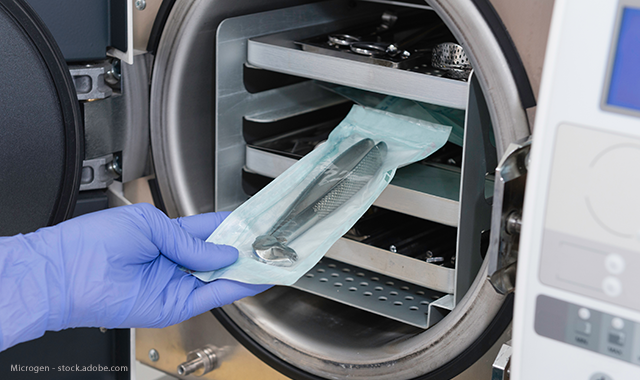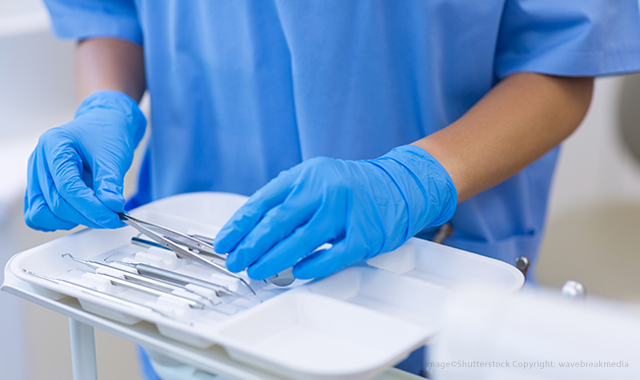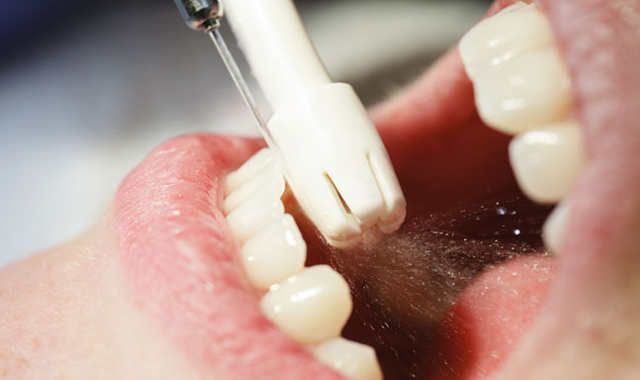3 pieces of infection control equipment you’re using improperly
Equipment maintenance practices are only effective when they’re used and maintained properly.
The equipment used as part of a practice’s infection control efforts is meant to help provide safe, effective care. But it isn’t enough to just simply have the equipment; that apparatus must be used and maintained properly.

Regrettably, it’s common for that equipment to be misused and misunderstood. The most common equipment mishaps are easy enough to correct, as long as the necessary steps are taken.
More from the author: Why money matters
Click through the slides to find out three pieces of infection control equipment you’re using incorrectly.


Sterilizer
The heart of the practice’s infection control efforts is the sterilizer. Unfortunately, it’s also the most frequently misused.
“A sterilizer that’s down causes all kinds of problems, including having to close the practice until a loaner can be provided or the practice’s sterilizer is repaired,” says Mary Borg-Bartlett, president of SafeLink Consulting. “There are different types of sterilizers; therefore, the practice should ensure that they have the manufacturer’s operating and maintenance manual for each type of equipment used in the practice.”
Not all sterilizers function the same, so it’s necessary to understand the method in which the practice’s sterilizer operates.
“If I have a gravity displacement unit, how does that work, in terms of how I load the sterilizer and how I run the cycles?” asks Leann Keefer, RDH, MSM, director of clinical services at Crosstex “Or, if I have dynamic air removal sterilizer, how does that method differ? The first part is they need to know what method of steam sterilization they’re using and they need to follow the appropriate IFUs for that method.”
Related reading: 5 ways to conduct infection control training in your office
Like a household dishwasher, sterilizers have different operation cycles used for various types of loads. Using the right type of cycle is crucial.
“Make sure you’re running the right cycle based on the instruments and the packaging material you’re using,” Keefer says. “You cannot run an unwrapped cycle when you have wrapped instruments, so you have to understand the different cycles that are available on your sterilizer.”
Too often, practices try to fit more instruments into the sterilizer than it can accommodate.
“The No. 1 issue that we see across the board is overloading the sterilizer,” Keefer says. “There is a weight/mass limit for every sterilizer validated by each manufacturer. And just because you can fit 72 pouches in the chamber doesn’t mean you should. Clinicians need to remember there is both a weight limit for the sterilizer and a right way to load the packs/pouches into the chamber.”
Maintenance shouldn’t be ignored, and it’s necessary on varying schedules.
“There can be daily, weekly and monthly maintenance tasks that are to be performed. These tasks should be performed on the basis directed by the manufacturer,” Borg-Bartlett says. “Distilled water is recommended for most steam sterilizers due to the fact that tap water could create a buildup of mineral deposits, which can lead to corrosion of tubing. When instruments that have been lubricated or dipped in dental milk are sterilized, they can leave a residue, so the sterilizer should be drained. They shouldn’t use bleach or other abrasives such as steel wool, wire brushes, or bleach in the autoclave chamber when cleaning. There may also be filters in the sterilizer that must be cleaned regularly. Most importantly, develop a maintenance schedule and follow the manufacturer’s instructions.
“Assign the responsibility of performing the maintenance to individuals who understand the operation of the equipment and will be accountable to ensuring that the maintenance is performed,” she continues. “Develop maintenance logs for each piece of equipment and have the people responsible for the maintenance sign-off that they have performed the maintenance task.”



Ultrasonic cleaners
Ultrasonic cleaners come with their own unique operational parameters and can pose their own use and maintenance challenges.
“It should be maintained by changing the solution daily, and also testing the equipment to ensure that it is working properly,” Borg-Bartlett says. “A common test is the use of aluminum foil that will show where the pitting occurs.”
Like other pieces of equipment in the practice, a common misstep with ultrasonic cleaners is not performing the required maintenance or monitoring.
Key to the ultrasonic cleaner’s operation is its cleaning solution, which must be properly used.
Trending article: Managing the fear factor
“Clinicians must be aware, when pouring new solution into the unit, the solution needs to be degassed before it’s used the first time,” Keefer says. “Often people are not aware that mixing a new solution from concentrate and water creates big bubbles, which, if not removed, can reduce the efficacy of cavitation.
“Consideration should be given to the frequency of changing that ultrasonic solution,” she continues. “At minimum, that solution should be changed once a day, but if you’re in a very busy practice, you may need to change it midway throughout the day. Because, essentially, it’s microbial soup, and when the unit is turned on, aerosols will be created. That is why it’s imperative to use the lid when operating an ultrasonic unit. Operating an ultrasonic without a lid creates a bioaerosol contamination up to three feet in the sterilization area.”
The manufacturer’s instructions for use (IFU) are especially important because not every piece of equipment is used exactly the same way. There are differences between manufacturer’s models that will affect their proper operation.
“Follow the manufacturer’s instructions for use as far as maximum weight of instruments placed in the ultrasonic basket,” Keefer says. “The rule of thumb is no more than two layers of instruments. It should not look like a cord of wood with a pile of instruments stacked on top of each other. There’s no way the cavitation bubbles are going to reach the center of the stack.”



Effluent water
Contaminated waterlines have received a lot of attention lately. It’s, of course, necessary to ensure that the waterlines leading to the patient are properly maintained, but what happens to the water after it has been used?
That used water is now going into the vacuum system and there are proper ways in which it should be handled. And, like so many other pieces of equipment, it all starts with understanding the manufacturer’s instructions.
“There are many types of pumps; therefore, the practice should consult the manufacturer’s instructions on how to maintain the equipment,” Borg-Bartlett says. “The drain lines from the operatory to the separator tanks in the vacuum pump are typically cleaned daily by using a cleaning solution recommended by the equipment manufacturer. This type of equipment usually has a solids collector, which some refer to as the ‘main trap.’ Some vacuum pumps require frequent cleaning of this collector, while others only recommend annually. Check the manufacturer’s instructions and follow those instructions for the equipment you’re using.”
More from the author: 3 steps to take to avoid sharps injuries
An often overlooked component of that system is the amalgam separator, which most dental practices are required to install by July 14, 2020. This will be another maintenance item that the practice needs to add to the equipment maintenance schedule.
“When we talk about amalgam separators, they should be checked to make sure that they’re not full,” Keefer says. “Go in, on a routine basis, look at that fill line, and see where you are on the fill line before you have to replace the canister and send off the other scrap amalgams to be recycled. Having someone who’s going in and doing a visual check is important because if it gets over full, what happens is it’s not going to separate out the amalgam and the amalgam is going to go out with the waste water.”
The equipment maintenance practices used as part of their infection prevention efforts are only effective when they’re used and maintained properly. By following the manufacturer’s IFUs - and paying attention to detail - dental professionals can ensure that they provide safe care to their patients.
